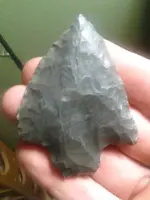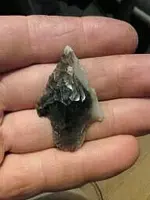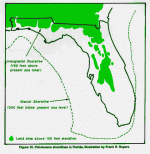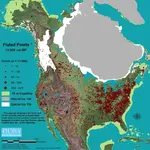Interesting topic and good thread. Out here in the east, where we've experienced the greatest crush of change and modern development, it's hard to really 'see' in your mind's eye, what this area looked like hundreds and thousands of years ago. First, the coastal plain extended miles from our current shoreline. Add to that the huge clear-cutting of trees when explorers first landed- and of course the development ever since. Europe had pretty much exhausted their supply of timber, clearing enormous swaths of territory for uses revolving around structure and boat building as well as iron smelting for weaponry. That said, there are quarry camps, production camps, base camps, annual hunting camps, and eventually, as the seas receded after the last ice age (Archaic), settlements across the formerly flooded 'plain'. All those camps are artifact-producing- some camps ranging from era to era depending on water- both for travel and for consumption. One thing I learned early on was to try to look for where good hunting would have been. That's not a camp site. That's where one goes- a measurable distance- away from a camp or settlement. N.A.'s were no dummies. You don't camp smack in the middle of your best hunting grounds. You camp a good distance away- but still 'travelable'. You make your tools at home and carry them off on a hunt or fishing trip. And although there are a ton of artifacts to be found in camps- established places where there are burial mounds, trash middens, post-hole marks (later, when they were building huts and staying in place), the best usable pieces- items that were not for ceremony or ritual or decoration- are found a bit distant from these camps (with the exception of kill sites, dead-fall sites, where they actually camped at the site of a kill, for a period of time).
From what I've read and studied, and from my experience out here, while there are many, many artifacts found in fields where settlements were eventually established, the mix is interesting and multi-generational. Also, where settlements are documented to have been, there's a lot of debris, and a ton of not-too-great points and pieces- which leads me to think that it's evidence of manufacture- like any debris remaining from manufacture. As an example, an old marble factory in PA has a dump area where one can find anything from scrap glass to perfect marbles- and everything in-between, all of which is interesting to find, as a 'dump-diver'. An archaeologist WAY down the road might look at such a dump and wonder why there are perfect marbles amid the debris of manufacture. And one might speculate the reasons. I feel its' much the same w/ N.A. artifacts and their locations, with regards to number, quality, use, reasons for 'being left or lost' at a certain location.
And the fact that clear-cutting of trees makes it hard to know what was always a field and what is presently a field isn't always clear or obvious. My own speculation, being an amateur, is that, like most modern folks, the original inhabitants camped and settled not in cleared fields, but on the periphery, in the protection of trees, out of flood-prone areas, with good drainage, and w/ access to water for travel and consumption. Over time, the open fields were intentionally expanded and grew, encompassing the old, forest-canopy camp-sites, causing all the debris and scatter of 'life' to appear to be in a field. If it were possible to up-root the new growth trees, untangle the roots and get below the couple-hundred-year-old loam, we might find the evidence of such a theory. But it's only that. A theory. My personal hypothesis.
More than anything, I think water plays a major factor in whatever terrain artifacts are found. As water-hunters know, artifacts both surf to the highest level they can when hit by tides or floods, landing on either beach or bar. And they gather in depressions amid the 'flow'- whether it's a river that's breached the banks and flowing over a field, or a one-directional river flowing over rocks and logs. I think that theory might apply to all land masses, at one time or another.
Yet another long-winded thesis... Thanks for getting through it all! Yakker








 Yak...yak yak yak yak
Yak...yak yak yak yak